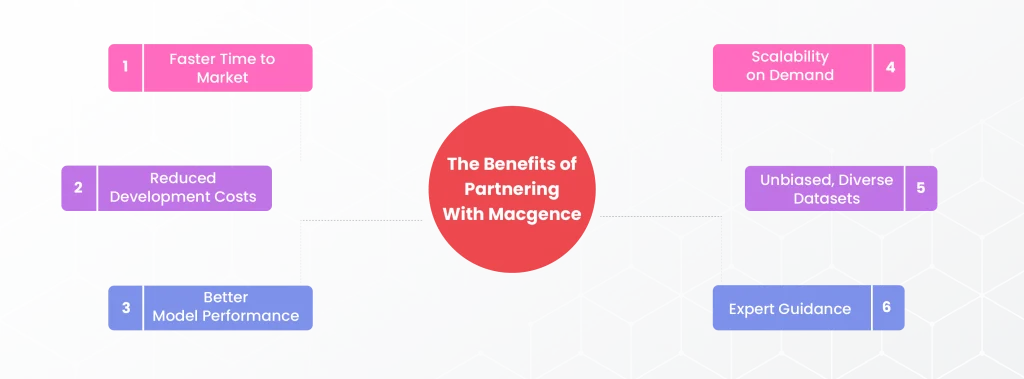- The Data Problem Every AI Builder Faces
- What is Synthetic Data?
- How Do You Actually Generate Synthetic Data?
- Why Companies Are Betting Big on Synthetic Datasets
- How Macgence Helps You Win With Synthetic Data
- The Benefits of Partnering With Macgence
- Real-World Applications We Enable
- Getting Started: What You Need to Know
- The Bottom Line
What is Synthetic Datasets? Is it real data or fake?
Picture this: You’re building the next breakthrough AI product. Your models need millions of data points to learn. But there’s a problem. You can’t access enough real-world data due to various factors, such as compliance issues, security factors, and specific needs.
Privacy regulations block you. Collection costs are sky-high. And even when you get data, it’s biased, incomplete, or just not diverse enough. Sound familiar? You’re not alone.
This is where synthetic datasets come in. They’re not just a workaround. They’re becoming the backbone of modern AI development. And if you’re a product manager, CTO, or data scientist building AI systems, understanding synthetic data isn’t optional anymore. It’s essential.
In this Blog, we’ll break down everything about what is synthetic dataset is. We’ll show you why companies are using them. And we’ll explain how we, Macgence, can help you generate high-quality synthetic data that actually moves your AI projects forward.
The Data Problem Every AI Builder Faces
Training AI models requires massive amounts of data. Not just any data, though. You need diverse, labeled, high-quality data. But here’s what happens in reality:
Privacy laws like GDPR and HIPAA restrict access to real user data. Data collection is expensive and time-consuming. We’re talking months, sometimes years. Real-world data often contains biases that hurt model performance. Rare events are underrepresented. This makes your AI miss critical edge cases. Labeling costs can drain your budget before you even start training.
Have you ever spent six months collecting data, only to find it’s not usable? It happens more often than people admit. Traditional approaches to data collection just don’t scale anymore. And that’s exactly why synthetic datasets have emerged as a game-changing solution.
What is Synthetic Data?
So, what is a synthetic dataset exactly? Synthetic data is artificially generated information. It’s designed to mimic real-world data. But here’s the key difference. It doesn’t contain actual observations from the real world.
Think of it like this: instead of photographing a thousand cars to train your computer vision model, you use algorithms to generate a thousand realistic car images that never existed. But synthetic data maintains the same statistical properties as real data. It has the same relationships. The same distributions. Even though it doesn’t come from actual recorded observations.
The beauty of synthetic data is that you can:
- Generate unlimited amounts of training data
- Create specific scenarios that rarely occur in real life
- Ensure perfect labeling (no human annotation errors)
- Stay compliant with privacy regulations
- Build diverse, unbiased datasets
And the best part? Research from MIT shows that AI models trained on synthetic data can actually outperform models trained on real data in certain scenarios. That’s not a theory. That’s proven results.
How Do You Actually Generate Synthetic Data?

There are several techniques we use to create synthetic datasets. Each has its own strengths. Let’s break them down.
1. Statistical Methods
Distribution-based approaches use statistical functions to define data distribution. Then they randomly sample from this distribution to generate new data points. This works great when you understand your data’s patterns well.
For time series data, interpolation can create new points between existing ones. It’s straightforward. And it’s computationally efficient.
2. Data Augmentation
This technique takes existing data and transforms it. Think rotating images. Adding noise to audio. Paraphrasing text. It’s one of the most common ways to expand your dataset quickly. And it’s relatively easy to implement.
3. Generative Adversarial Networks (GANs)
GANs use two neural networks that compete. One generates synthetic data. The other evaluates and classifies it. Both work together until the evaluating network can’t tell the difference between synthetic and real data. GANs are powerful for creating highly realistic images, videos, and complex data structures. They’re particularly good at capturing fine details and variations. However, they can be tricky to train.
4. Variational Autoencoders (VAEs)
VAEs use algorithms that generate new data based on representations of original data. They learn the distribution characteristics. They compress data into a latent space. Then they reconstruct it with variations. While VAEs might produce slightly less sharp images than GANs, they’re not susceptible to the mode collapse problem that GANs sometimes face. This makes them more stable for certain applications.
5. Machine Learning Algorithms
Modern ML techniques can learn patterns from your existing data. They generate completely new samples that follow the same rules and characteristics. These approaches are getting more sophisticated every day.
Why Companies Are Betting Big on Synthetic Datasets
Let’s get real about why synthetic data is taking off. Here’s what’s driving adoption across industries.
Privacy and Compliance
You can’t mess around with regulations anymore. GDPR fines can reach millions. HIPAA violations can shut down your healthcare AI project entirely.
Synthetic data lets you share datasets internally or externally. And you don’t reveal personally identifiable information. Problem solved.
We’ve worked with healthcare companies that need to train diagnostic AI. But they can’t share patient records. Synthetic data solved that problem completely. Now they can collaborate with research institutions without legal risk.
Cost Efficiency
Real data collection is brutal on budgets. Field teams. Equipment. Annotators. Quality control. It all adds up fast. Synthetic data generation costs a fraction of that. You can create millions of labeled examples in hours instead of months. For startups with limited resources, this is a game-changer.
Handling Rare Events
Your self-driving car AI needs to recognize a child running into the street. But that scenario (thankfully) rarely appears in training data. Synthetic data can introduce rare scenarios and edge cases. This ensures models learn how to handle a broader range of situations. Your AI becomes more robust. More reliable. Safer.
Eliminating Bias
Real-world datasets often reflect societal biases. Facial recognition that doesn’t work for certain ethnicities. Voice assistants that struggle with accents. Hiring algorithms that discriminate.
Synthetic data lets you intentionally create balanced, diverse datasets. Datasets that represent everyone. Not just the majority group in your training data.
Rapid Iteration
Need to test how your model handles different lighting conditions? Weather patterns? User behaviors? With synthetic data, you don’t wait for those conditions to occur naturally. You generate them on demand. Test. Iterate. Improve. All in days, not months.
Scaling Without Limits
Sometimes getting enough real-world data for training machine learning models is extremely difficult. Fabricated data can augment available real data. It increases the dataset size dramatically. This is huge for startups and research teams. Teams that don’t have access to massive proprietary datasets. Synthetic data levels the playing field.
How Macgence Helps You Win With Synthetic Data
So now that you understand why synthetic data matters, let’s talk about implementation.
Here’s where things get practical. At Macgence, we’ve been helping AI companies generate and annotate training data for over five years. We know that synthetic data is only valuable if it’s high-quality, relevant, and actually helps your models perform better.
Here’s how we can help you.
Custom Synthetic Data Generation
We don’t believe in one-size-fits-all solutions. Your AI application is unique. Your synthetic data should be too. We work with your team to understand your specific use case. Then we generate synthetic datasets that match your exact requirements. Whether you need synthetic images for computer vision, synthetic audio for speech recognition, or synthetic text for NLP models, we’ve got you covered.
Domain Expertise Across Industries
We’ve worked with companies in healthcare, autonomous vehicles, retail, finance, and more. Our team understands the nuances of different domains. For medical imaging, we generate synthetic datasets that maintain clinical accuracy. For autonomous driving, we create diverse traffic scenarios with proper physics simulations. Retail, we build customer behavior patterns that reflect real shopping journeys.
Hybrid Approach: Real + Synthetic
Hybrid synthetic data combines real datasets with fully synthetic ones. It takes records from the original dataset and randomly pairs them with synthetic counterparts.
We help you find the right balance. Sometimes pure synthetic data works best. Other times, augmenting your existing real data with synthetic examples gives you the performance boost you need. We test both approaches and recommend what actually works.
Quality Assurance and Validation
Generating synthetic data is one thing. Making sure it’s actually useful is another. We validate synthetic datasets against real-world distributions. We test them with your models. And we iterate until performance metrics meet your targets. Our ISO-certified processes ensure data quality at every step.
You don’t get synthetic data and hope it works. You get validated, tested, production-ready datasets.
Privacy-First Solutions
When you work with us, your data security is paramount. We’re ISO-27001, GDPR, and HIPAA compliant.
Whether you need fully synthetic datasets or partially synthetic data that protects sensitive information, we ensure regulatory compliance. Your legal team can sleep at night.
End-to-End Support
From initial consultation to data generation to annotation to model testing, we support you throughout the entire AI development lifecycle.
You’re not just getting a dataset. You’re getting a partner who understands AI challenges. Who’s solved problems like yours before? Who can help you avoid expensive mistakes!
The Benefits of Partnering With Macgence

When you choose Macgence for your synthetic data needs, here’s what you get.
Faster Time to Market
Stop waiting months for data collection. With our synthetic data generation capabilities, you can have training datasets ready in days, not quarters. This speed advantage enables you to iterate more quickly. Launch products sooner. Beat competitors to market. In fast-moving AI industries, speed is everything.
Reduced Development Costs
Data collection and annotation typically eat up 80% of AI project budgets. That’s not an exaggeration. Our synthetic data solutions can significantly reduce these costs while maintaining quality.
One client reduced their data preparation costs by 65%. Another cut time-to-production by 4 months. These aren’t outliers. They’re typical results.
Better Model Performance
Synthetic data can improve model robustness and accuracy. Especially for handling edge cases and rare scenarios.
Our clients consistently see performance improvements when they augment real data with our synthetic datasets. Because synthetic data lets you train on scenarios that real data never captures.
Scalability on Demand
Need 10,000 examples today and 100,000 next week? No problem.
Synthetic data generation scales effortlessly. We can ramp up production based on your project needs. Say goodbye to logistics nightmares. Leave hiring annotators behind. End quality control bottlenecks for good.
Unbiased, Diverse Datasets
We actively work to eliminate biases in synthetic data generation. Whether it’s ensuring gender balance, ethnic diversity, or geographic representation, we help you build AI that works for everyone.
Because AI that only works for some people isn’t good AI. It’s a flawed AI.
Expert Guidance
Our team includes data scientists, machine learning engineers, and domain experts. They understand both the technical and practical aspects of AI development.
We don’t just deliver data. We advise you on the best approach for your specific use case. What techniques to use? How to validate results. When to use real vs synthetic data.
Real-World Applications We Enable
To make this more concrete, here’s how this plays out in practice.
Here are a few examples of how we’re helping companies use synthetic data.
- Autonomous Vehicles: We generate synthetic LiDAR and camera data showing diverse traffic scenarios. Different weather conditions. Edge cases that rarely occur in real driving but are critical for safety. Pedestrians in unusual positions. Cyclists making unexpected moves. Animals on the road.
- Healthcare AI: Creating synthetic medical images and patient records. They maintain clinical accuracy while protecting patient privacy. This enables diagnostic AI development without HIPAA violations. Hospitals can share data. Researchers can collaborate. Innovation accelerates.
- Retail and E-commerce: Generating synthetic customer behavior data. Product images with different lighting and angles. Transaction patterns for recommendation engines. All without exposing real customer information or collecting data for months.
- Financial Services: Creating synthetic transaction data for fraud detection models. Ensuring rare fraud patterns are well-represented without exposing real customer information. Banks can develop better fraud detection without risking data breaches.
- Natural Language Processing: Building synthetic conversation datasets. Multilingual text samples. Dialogue patterns for chatbots and virtual assistants. With perfect labeling and diverse scenarios that real conversations might never capture.
Getting Started: What You Need to Know
If you’re considering synthetic data for your AI project, here’s our advice.
- Start with a clear use case. Don’t generate synthetic data just because everyone’s doing it. Identify specific problems. Data scarcity. Privacy concerns. Bias issues. Target those problems directly.
- Validate early and often. Generate small synthetic datasets first. Test them with your models. Measure performance before scaling up. Don’t assume synthetic data will work. Prove it works.
- Combine approaches. Sometimes pure synthetic data works. Often, a mix of real and synthetic data gives the best results. Test both. Let data guide your decisions, not assumptions.
- Think long-term. Synthetic data infrastructure is an investment. The upfront work pays dividends. Because you can rapidly generate new datasets for future projects. Your second AI model will be faster to train than your first.
The Bottom Line
After reading all this, you might be wondering what your next step should be.
What is a synthetic dataset? It’s not just artificial data. It’s a strategic tool that can accelerate your AI development. Reduce costs. Ensure compliance. And improve model performance. The AI landscape is changing fast. Companies that figure out how to leverage synthetic data effectively will have a massive advantage. Those who stick to traditional data collection methods will struggle. They’ll struggle with costs. Regulations. Scalability.
At Macgence, we’ve helped hundreds of AI teams navigate these challenges. We combine technical expertise, domain knowledge, and a commitment to quality. This ensures your synthetic datasets actually work. Not just in theory. In production.
Ready to explore how synthetic data can transform your AI project? Let’s talk about your specific needs. We’ll build a solution that works for you.
Because in the world of AI, the quality of your data determines the success of your product. And with synthetic data, you’re no longer limited by what already exists. You can create exactly what you need.
Get in touch with Macgence today. Discover how we can help you build better AI with synthetic datasets that actually deliver results. Schedule your free 15-minute consultation now.
You Might Like
October 11, 2025
Why Your AI Can’t Understand Humans: The Multimodal Conversations Datasets Gap
Your conversational AI is failing, and you probably don’t know why. It responds to words perfectly. The grammar checks out. The speed is impressive. But somehow, it keeps missing what users actually mean. The frustrated customers. The sarcastic feedback. The urgent requests are buried in casual language. Here’s what’s really happening: your AI is reading […]
October 10, 2025
Why Your Self-Driving Car Needs Perfect Vision: The LiDAR Annotation Story
Imagine you’re driving down a busy street. Your eyes are constantly scanning – pedestrians crossing, cars merging, cyclists weaving through traffic. Now imagine teaching a machine to do the same thing, except it doesn’t have eyes. It has lasers. And those lasers need to understand what they’re “seeing.” We’ve seen many product launches that aim […]
October 6, 2025
What Are the Most User-Friendly Geospatial AI Solutions?
Finding the correct geospatial AI platform should not feel like navigating a maze. Yet, for product managers and CTOs, choosing solutions that strike a balance between power and usability often becomes the biggest challenge in deploying location-based intelligence. The geospatial AI market is estimated to reach $2.3 billion by 2027, but here’s the one thing: […]




